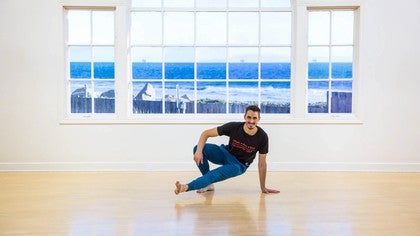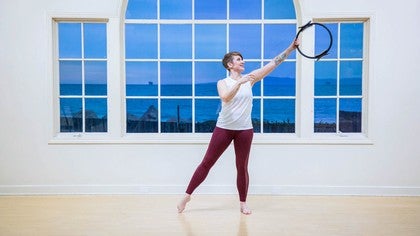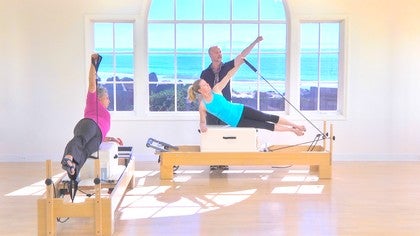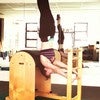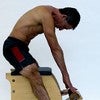Description
About This Video
Transcript
Read Full Transcript
Hello. I am Jennifer Golden Zuman and I am very happy to be back here at Palazzos anytime again. Today I'm going to do some exercises on the Cadillac. We're going to do a bit of monkey business today. We're going to focus on how we utilize the upper body for overall body health, and I'm going to throw a couple of concepts in there as well while we're working. But first I'm going to show you what we're going to use so you can get everything prepared if you're going to do it. Along with me, I've got my trapeze bar set up with the sling beneath.
We've got the fuzzy straps aren't as well, and I'm also going to use this breathing sling, which is a wonderful item here that you can use with pretty much the rollback bar slings. If you don't have one of these, you can snag a foot strap off your reformer or any other kind of sling will work. We're gonna use some arm springs. I'll just put 'em away as I described. And then we're also gonna use the rollback bar. So I'm going to clear this stuff out of the way. We're going to get up on top and we're going to start right away thinking about what it's like for humans to climb.
So the first thing we're going to think about is the squat, but we're going to combine the squat with a little bit of an upper body feeling to it. Looking at the broad musculature and connective tissue that connects the arms through the front and through the back of the body, down into the legs. We're going to focus on the idea of climbing, but I want to suggest that within that idea of climbing is as much leg activity as arm activity. Essentially climbing is crawling upwards, so we're going to begin with our legs and feet and ankles to get a little bit of sense of spring. So you can hold on to the verticals here just so you can lower yourself down into a comfortable squat.
Don't lean back too far and do lift your heels when you feel they need to if you feel they need to. And we're going to rock forward a little bit into the ball of the foot, spreading the pads of the toe balls, bed. And then without bringing the knees back too far, we're going to lower the hinge of the ankle. And let's just rock that a few times. If it's not comfortable for your knees, just do it as low as you can or please some pads were rolled up. Towel behind your knees to protect them from bending too far.
After a few of these, we're going to stand up straight up, not going to roll up. We're not going to fold back up and it's gonna go straight up. And then we're gonna go straight back down. And then we're going to go straight up again and straight back down. And I want you to give your arms a bit of this job.
So start to your arms to be involved. So you're balancing the leg straightening with the arm, pulling, beginning to activate the whole body. To do this together, we're going to take this one step further. Now we're going to hold on to the top. And this time when you dropped down, I want you to imagine it's a combination of a stand up and a pull up.
We'll do a few more of these up here, working evenly with the arms and legs. Now this won't do it for you. You have to decide to find a balance between your arms and legs. And then we're going to take one leg off as we squat and Paul up and switch legs.
Now we're going to hang off the side and get a little bit of links in the body, so lower yourself down slowly and if you feel it's acceptable, you'll bring your legs down. We're going to bring up one leg and as it comes down, a little extension
I really enjoyed doing this using the fuzzies because it gives me a chance to spiral the arms a little bit. So you're going to bring your hands through, grab on and pull so your hand gets more solid in there.
This is fun. Just enjoy it. You rock a few times and on the next one you're going to hold yourself up and switch legs. That's the trick. And we'll do about four here.
It's tempting to say, I want to tighten my abs. I want to use everything so we exhale hard, but we need to inhale and strengthen our diaphragm so we can exhale efficiently as well. All right. Now we're going to go ahead on to setting up the breathing slang on this side. I'm just going to flip these guys out of the way.
Now I don't care if you know the name, but I do care if you know where it is. It is similar to what we're gonna do with this harness. It's along the back this way and it draws the ribs towards the spine on the exhale, which prevents us from collapsing the ribs on this side of the exhale. So we breathe in, feel harness of it, and as we exhale, it slides towards the midline. Now, it doesn't do that all by itself, but what it does is stimulate the broad fashion of the back to remember to cinch at this direction and not just this direction. This is a wonderful reminder from now on, I'm going to call that muscle SPI.
That's what I call it. That's his nickname around my parts. So you're going to put this around your back and they're just going to have a seat. What's nice is this gives us some support through that mid spine.
We want to avoid collapsing in the thoracic spine when we try to roll, and that's what this will do for us. It's supports and allow yourself to be lifted and then we all will exhale and roll the pelvis back. Inhale here and then exhale, roll forward. Allow yourself to be lifted by the sling and again, gives us a good opportunity to isolate the low back and the low belly. For any of you that have ever had children and have gone through pregnancy, this is a wonderful way to get out of that tilt that likes to stay with your pelvis for the next number of decades afterwards.
No, after the rollback, we're going to do a hinge back. We're going to bring your hands behind your head and feel the elbow spiral upwards, lifting you up now. Just lean back and then find a balance of being lifted and resisting. If it's possible to do this with your legs straight, go right ahead.
Breathe in and breathe out. We're working the abdominals in a very long way here. One more time. Now we're going to put that together so we're going to hinge back and then we're going to curl and then we're going to lift back up and be lifted by the sprays, hinge, curl, lift and be lifted one more time. Developing some control of these muscles allows us to have better control of the rib cage without having to compress them in the front. Now we're going to twist, twist, and lean and then resist as you come back up. Inhale and exhale.
Inhale and exhale and one more good. Now to get out of here safely, you have to let it go slack a little bit, so I recommend sitting up first and then taking it off. Otherwise it'll smack you on the back of your head and that will be fun. Going to take off the breathing slang and I'm going to trade it out with the rollback bar. All right. We've replaced the breathing slang with the roll back bar. So we're going to have a seat and we're just going to start with a couple of straight rollbacks because I just love these. So I like to inhale on the initiation.
Inhale as you slide the hamstrings, slide the sitting bones into the hamstring and then exhale, unfurl the spine back down to the mat. Inhale to inflate the upper spine and lift and then exhale to roll back forward. Stretch all the way up the angle of the springs and keep in tune with that SPI harness that you have built in for yourself so you don't collapse as you come up. Inhale and exhale.
We have the receptors that tell us where to move and what to do. But what we also have is internal sensors that give us more of a sensory relationship and there are many, many of those in within this Oregon bag. So what we do in [inaudible] is really that body, mind relationship. For the next one, we're going to spiral a little bit. We're going to put your feet underneath the strap.
So we're going to start with the twist and we're going to three times saw back. And on that last one we're going to rotate all the way onto your hip and lift up through the waist and reach and then let the springs lift you. And let's go to the other side.
We're going to do a little sequence that I call the abdominal massage sequence. The idea is we cannot squeeze the abdominals. As we inhale, we inflate everything and as we exhale we let the elasticity return it and try not to collapse through the rib cage. So starting with the legs bent in a comfortable shelf position, we're going to inhale in, roll to the right, find the moment of resilient return to exhale and pull you back so we're not really muscling it. Inhale, we're tuning into our, as we exhale our elasticity. If you go too far, the Yoyo won't come back up. We want to find your body's resilient range. One more of these to each side. Inhale, the shoulders do very little.
The arms are just stabilizing you. Complete inhale and complete. Exhale. Now we're just going to take the right leg away from the midline in. Roll it back into the socket again. We're looking for our resilient range. When were these to each side?
She'd be like a windshield wiper. Not coming closer or further away, but just opening up, staying on the windshield. Now the legs will come up straight. We're going to repeat that same idea, but this time we're going to let the pelvis rotate.
And then we're going to continue into the roll up. So we roll up and follow the angle of the springs and then we'll roll the spine back down. Bringing the feet to the floor. Now I'm not too concerned where you're breathing in and out. I'm mostly concerned that you are breathing in and out. So whichever pattern feels more organic for your body, makes sure the breath is complete.
And with each inhale you're completely filling the upper part of the lung as well as the lower and that you're exhaling thoroughly. Now we're going to do with the Ferris wheel, so we're going to come up and lift the hips to come down and bounce right back the way you came. Roll Up. So we get to go from flection to extension in mid air.
I hope you guys are getting that kind of workout too. So now we're going to roll back. We're going to find a hammock in the body. So we're going to roll through the spine and I want you to imagine that you're resting in a hammock so it doesn't require a lot of work in the upper body. It just requires letting your arms create this hammock shape and you're going to inhale slide one leg and exhale, draw it back in.
The real challenge here is not to allow your pelvis to get pulled up. So if you need to adjust that, you can get a little closer in. The bar. Won't be pulling you quite so much.
Your feet come down and then you roll up. Let's do three more of those
And now I want you to imagine that as you get through here and you elongate from sitting bones to Crown
That's quite all right. We come up again and down
Well, so it doesn't become a guillotine on you while you do this next exercise. So we're getting just an extension work here. Now the key to extension work for getting a good thrust to your upper spine is to get a good activation through the sacrum and the back of the legs. So we're going to use this strap here. Now I really like if you can get the strap to be up really at the upper part of your hamstrings. It gives a nice signal.
So let's see how we're going to get in here. We're just gonna slide on in. We're going to be laying on your belly off the front of your machine. So let's see. Can you put your hands on the floor? And you're going to scoot yourself in. Now you want to place yourself on here. So your front hip bones are at the very edge, so they're on, but all the softer tissue is off. And this gives you some nice feedback.
So when you take a breath in and then you exhale, you should feel the bones stay against the table. But all the softer stuff, lift away from the table. It probably won't lift away from the table, but it shouldn't be your point of contact with the edge. Now the first thing we're going to do is just hang down, let your forehead rest onto your hands and you really might just want to stay here all day. Actually, this might just be the end of your workout, but I'm going to take us a little further. So we're going to lift the legs into the strap.
Please keep them parallel here and Elongate the spine forward. Think less about upwards. Think more about forwards and then back down and again, reach
So we're just going to lift up and now you have to work a bit to press back down. But I don't want you to change the shape of the shoulders. I don't want you to round your shoulders out.
The connective tissue of your neck is connected all the way down into the tissue, around your lungs and heart. So turning your head stimulates the organs in the chest cavity. Now the opposite arms going to go forward and bring them both back down other side. Bring them both back down. Now this is harder to control than it looks, so don't be surprised if it takes you a while to get to all these. No, bring them forward and Poe down. Forward, rise up, pull down one more.
So you're going to wiggle yourself forward till your feet come out. And then just step one foot at a time down to the floor. We're going to make our way now over to the other end of the machine and we're going to do some leg springs. I have the leg springs set up over here because I kind of like to use the push to bar sometimes when I'm doing leg springs, which I'll show you in a bit. So first we're just going to do some straight leg springs lying on your back, putting both feet in.
I'm a big believer of trying to put your feet in at the same time and then press out so your arms are straight. The first one goes by many names, but I'm going to call it dolphin because of where we are. So the inner edge of the foot is going to stay together. The feet will come down, slide out, come up and then bend back in, down, slide out. And because of the exercises we've done previously, you should have a very good sense of control of your torso without having to be rigid through the rib cage, switched directions, reach.
So we've got a very dynamic sense of control, moveable and pliable. Two more times, I'm going to turn it into circles. Now, open, left hips roll through the socket. I like to give a sense of stimulating the socket, so try to explore the hip socket as you roll with each leg and note where and how they feel different switched directions. They will inevitably feel different and that's okay. Each leg just has to do their best. It doesn't have to be like the other two more times. Good. Now we're going to take them off and we're going to turn onto your side.
I have the push through bar with no springs on it. I'm just going to use it to give me some feedback through the upper body, so I'm going to use the front spring. If you prefer the back, that's fine, but for now I'm going to use the front spring. I'm going to rest my lower hand so my head is on it and my other hand is going to be right there at the front corner of the bar. As my leg goes forward, I'm going to bring the bar back. As my leg goes back, I'm going to allow my torso to rotate a bit without losing this torso control.
I've been developing this whole time. So the key is once your body has done it, once we've done a principle in the class, in your workout, it stays. So we worked on rib kids' control. It's here to stay. You're not allowed to let it go just because we're not on that exercise anymore. One more good and we'll take that off your foot and turn to the other side.
Legos forward and the arm comes back. Finding the connection from the upper and lower body. We've got a very nice, very direct Fastenal connection from the one arm and out through the legs and we're exploring the elasticity of that connection in both the front and in the back body here. One more. Good. Alright. And we'll take that off here. Okay.
Now we're going to do a little bit of a side bend exercise while we're here with the push through bar, we don't want it to be lonely. Going to attach a spring here. We're going to bring the hand to the middle of the bar and you're going to lay off this side. Now, if you feel unstable here, just slide your strap over and put your feet in it. It gives a different dynamic to this exercise, but I want you to have your rib cage off the side. The other arm is going to be down. We're going to come up.
Let the bar lift you when you get here, turn and then look towards the floor. Remember how I mentioned that the tissue of the neck connects down into the rib cage. So imagine that as we do this, we are massaging the lungs and the heart fulfilling Mr [inaudible] request for a whole body fitness exercise, internal and external health. Either side, turn the head, but not so much of the torso. See if you can control the difference two more.
All right, we're going to put this down. We're going to go back up again and we're going to do some inversions. If you're sweaty like me, probably going to need something sticky for your hands to be on. All right, I'm ready to hear with my stickies and I set my trap. He's bar back up very close to this end. We're going to do a suspended side plank and push up pull up kind of kind of thing. So we're going to be off the side here.
So you're going to step off the side, Hook your feet up into your trap piece. The hands are going to be pretty narrow here. You got to keep them pretty narrow and you're going to hang down. The first thing we're going to do is just stretch out and do a pull up slowly descend. That is the key with things like pull ups is to work during the e centric moment.
So right here to really get work now can to keep one hand on and drop the other hand down and then come back to the center and do a pull up. If you're up to it other side, bring your feet closer together. And as you let go of one side, you're going to keep going and bring your knee through. And if you're up to it, throw in a pull up, why not? And then the other side, let go first. Keep turning, bring your knee through, back open. Of course, do not attempt this on your own without a spotter if you're not totally confident in your grip. A lot of people don't have a very strong grip when they begin.
But consider how important our grip is to climbing. You're going to climb something. You don't start with your shoulders, you start with your, your grip. So it's just something that needs to be developed. All right, we're going to move this guy out of the way. Now all the way down to the end, we're going to unfold our fuzzies and get ready for a couple more fun upside down, hanging around things we've been building to this moment. Kay, we're gonna do an inside out stretch. And actually what I'm going to do instead of holding on to here is hold on to the fuzzy. So I'm going to put these down for the moment to wait. So the hands will go into the fuzzies.
We're going to step up with one foot and swing over so your feet come to the end and hang down and then pull yourself back through and control your return. Then step up with the other foot. Foot goes up. Climb yourself over.
And then we're gonna do another suspended twist. So I'm going to set these guys up over here this time.
Anything Goes: Playing with Pilates
Comments
You need to be a subscriber to post a comment.
Please Log In or Create an Account to start your free trial.
